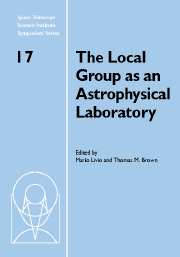 The Local Group as an Astrophysical Laboratory
The Local Group as an Astrophysical Laboratory Book contents
- Frontmatter
- Contents
- Participants
- Preface
- History of the Local Group
- Primordial nucleosynthesis
- Galactic structure
- The Large Magellanic Cloud: Structure and kinematics
- The Local Group as an astrophysical laboratory for massive star feedback
- Hot gas in the Local Group and low-redshift intergalactic medium
- Stages of satellite accretion
- The star formation history in the Andromeda halo
- Bulge populations in the Local Group
- The Local Group as a laboratory for the chemical evolution of galaxies
- Massive stars in the Local Group: Star formation and stellar evolution
- Massive Young Clusters in the Local Group
- Magellanic Cloud planetary nebulae as probes of stellar evolution and populations
- The old globular clusters: Or, life among the ruins
- Chemical evolution models of Local Group galaxies
Galactic structure
Published online by Cambridge University Press: 12 May 2010
- Frontmatter
- Contents
- Participants
- Preface
- History of the Local Group
- Primordial nucleosynthesis
- Galactic structure
- The Large Magellanic Cloud: Structure and kinematics
- The Local Group as an astrophysical laboratory for massive star feedback
- Hot gas in the Local Group and low-redshift intergalactic medium
- Stages of satellite accretion
- The star formation history in the Andromeda halo
- Bulge populations in the Local Group
- The Local Group as a laboratory for the chemical evolution of galaxies
- Massive stars in the Local Group: Star formation and stellar evolution
- Massive Young Clusters in the Local Group
- Magellanic Cloud planetary nebulae as probes of stellar evolution and populations
- The old globular clusters: Or, life among the ruins
- Chemical evolution models of Local Group galaxies
Summary
Our Milky Way Galaxy is a typical large spiral galaxy, representative of the most common morphological type in the local Universe. We can determine the properties of individual stars in unusual detail, and use the characteristics of the stellar populations of the Galaxy as templates in understanding more distant galaxies. The star formation history and merging history of the Galaxy is written in its stellar populations; these reveal that the Galaxy has evolved rather quietly over the last ∼10 Gyr. More detailed simulations of galaxy formation are needed, but this result apparently makes our Galaxy unusual if ∧CDM is indeed the correct cosmological paradigm for structure formation. While our Milky Way is only one galaxy, a theory in which its properties are very anomalous most probably needs to be revised. Happily, observational capabilities of next-generation facilities should, in the foreseeable future, allow the acquisition of detailed observations for all galaxies in the Local Group.
Introduction: The fossil record
The origins and evolution of galaxies such as our own MilkyWay and of their associated dark matter haloes are among the major outstanding questions of astrophysics. Detailed study of the zero-redshift Universe provides complementary constraints on models of galaxy formation to those obtained from direct study of high-redshift objects. Stars of mass similar to that of the Sun live for essentially the present age of the Universe and nearby low-mass stars can be used to trace conditions in the high-redshift Universe when they formed, perhaps even the ‘First Light’ that ended the Cosmological Dark Ages.
- Type
- Chapter
- Information
- The Local Group as an Astrophysical LaboratoryProceedings of the Space Telescope Science Institute Symposium, held in Baltimore, Maryland May 5–8, 2003, pp. 33 - 46Publisher: Cambridge University PressPrint publication year: 2006
- 1
- Cited by


